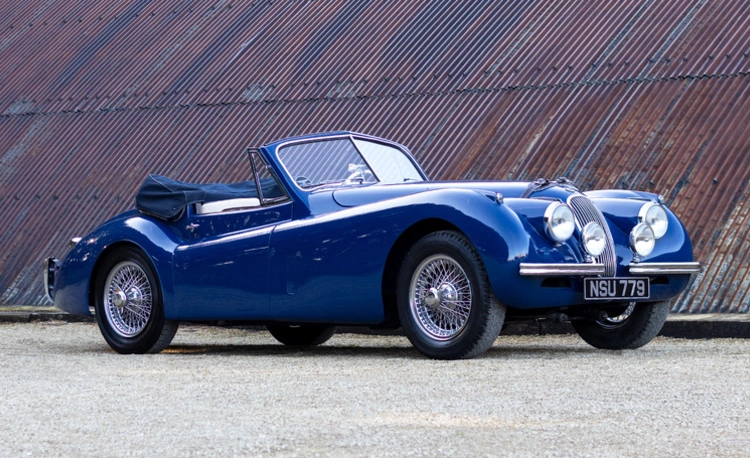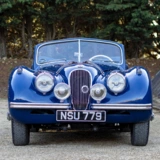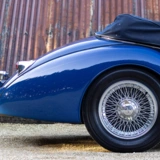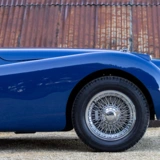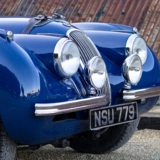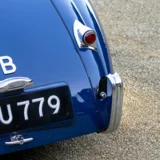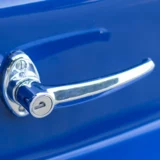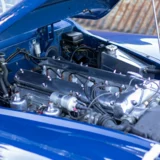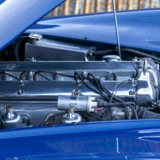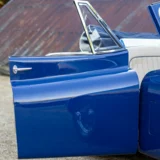Weitere Anzeigen dieses Anbieters
Alle anzeigen

Das könnte Sie auch interessieren
Alle anzeigen

Impressum & AGB
Impressum
Get in touch
- T: 0044 / (0) 1242384092
- E: info@classicmotorhub.com
Classic Motor Hub, Old Walls, Ablington, Bibury GL7 5FF / GL7 5NX
AGB
Terms & Conditions
These terms and conditions help ensure that ClassicMotorHub.com is a safe place to trade and set out the full extent of any agreement reached between you and ClassicMotorHub.com in connection with this site. You should understand that by placing an order, you accept the following terms and conditions:
GENERAL
The owner of ClassicMotorHub.com is The Classic Motor Hub, whose address is Old Walls, Ablington, Bibury, Gloucestershire, GL7 5NX. Company registration number: 10423951.
You agree that your e-mail can be used as a means of communication.
No contract for the sale of any product will subsist between you and ClassicMotorHub.com unless and until ClassicMotorHub.com accepts your order by way of an e-mail confirming it. That acceptance will be deemed complete and will be deemed for all purposes to have been effectively communicated to you at the time ClassicMotorHub.com sends the e-mail to you (whether or not you receive that e-mail). This confirmation e-mail amounts to an acceptance by ClassicMotorHub.com of your offer to buy goods from The Classic Motor Hub.
This confirmatory e-mail will contain all relevant information concerning your order.
You must check that the details on this confirmatory e-mail are correct as soon as possible and you should print out and keep a copy of it.
You undertake that all details you provide to ClassicMotorHub.com for the purpose of ordering or purchasing goods or services are correct, that the credit or debit card you are using is your own and that there are sufficient funds to cover the cost of the goods or services ordered.
If there are any changes to the details supplied by you it is your responsibility to inform ClassicMotorHub.com as soon as possible.
You may cancel your order at any time prior to your order being processed by email to info@classicmotorhub.com or by post or by telephoning 01242384092 during normal office hours.
You may also withdraw from the contract at any time after the product has been dispatched and you have received our email confirming your order by:
11.1 sending the notice of cancellation by email to info@classicmotorhub.com ensuring that you quote your name, address and order reference number;
and/or
11.2 where you have already received the goods, returning the goods to The Classic Motor Hub undamaged.
Once ClassicMotorHub.com receives notification from you that you wish to withdraw from the contract (in accordance with these terms) any sum debited to ClassicMotorHub.com from your credit card in relation to your order will be re-credited to that credit card account as soon as possible and in any event within 30 days of your order provided that the goods you wish to return are received by The Classic Motor Hub in the condition that they were in when delivered to you.
LIABILITY
This Liability section applies only to the extent permitted by law. For the avoidance of doubt, ClassicMotorHub.com do not exclude or limit any liability for (a) personal injury (including sickness and death) where such injury results from ClassicMotorHub.com’s negligence or wilful default, or that of ClassicMotorHub.com employees, agents or subcontractors or (b) fraudulent misrepresentation.
ClassicMotorHub.com does not accept liability (except as set out below) for any errors and omissions and reserve the right to change information, specifications and descriptions of listed goods, products and services.
ClassicMotorHub.com will do its best to correct errors and omissions as quickly as practicable after being notified of them.
TO THE FULLEST EXTENT PERMITTED BY LAW, ClassicMotorHub.com IS PROVIDING THIS WEB-SITE AND ITS CONTENTS ON AN “AS IS” BASIS AND MAKES NO (AND EXPRESSLY DISCLAIMS ALL) REPRESENTATIONS OR WARRANTIES OF ANY KIND, EXPRESS OR IMPLIED, WITH RESPECT TO THIS WEB-SITE OR THE INFORMATION, CONTENT, MATERIALS OR PRODUCTS INCLUDED IN THIS SITE INCLUDING, WITHOUT LIMITATION, WARRANTIES OF MERCHANTABILITY AND FITNESS FOR A PARTICULAR PURPOSE. IN ADDITION, WE DO NOT REPRESENT OR WARRANT THAT THE INFORMATION ACCESSIBLE VIA THIS WEB-SITE IS ACCURATE, COMPLETE OR CURRENT.
In the unlikely event that you receive goods which were not what you ordered or which are damaged or defective, or are of a different quantity to that stated on your order form, ClassicMotorHub.com shall, at its own option, make good any shortage or non-delivery, replace or repair any damaged or defective goods, or refund to you the amount you paid for the goods in question PROVIDED THAT you notify ClassicMotorHub.com of the problem. NOTHING IN THIS CLAUSE AFFECTS YOUR STATUTORY RIGHTS.
ClassicMotorHub.com do not accept liability for any indirect loss, consequential loss, loss of data, loss of income or profit, loss of damage to property and/or loss from claims of third parties arising out of the use of the ClassicMotorHub.com web-site or for any products or services purchased from ClassicMotorHub.com.
ClassicMotorHub.com will only be liable for direct loss up to a maximum total of the price of the product or service purchased in respect of any claim.
PROCESSING OF ORDERS
Credit and Debit cards are debited prior to despatch. All prices include sales taxes (where applicable) unless otherwise stated.
Every purchase you make shall be deemed performed in the United Kingdom. United Kingdom law shall govern every aspect of contractual agreement concerning purchases made from this web-site.
ClassicMotorHub.com aim to arrange shipment of all in stock items on the business day your order is received providing it reaches us by 3pm. Your order may be delayed if the item is not in stock. Some items may be unavailable and the current stock status is approximate. ClassicMotorHub.com can only supply approximate dates our suppliers may get an item in stock.
DELIVERY/TITLE/RISK
The period stated within which you will receive your order is approximate. Goods will be sent to the address given by you in your order and stated in the Order Confirmation. Please note that your goods may be sent to you in instalments.
Title to any product ordered will pass to you once ClassicMotorHub.com has received payment in full for that product.
If your delivery address is outside of the United Kingdom you maybe subject to import duties and taxes, which are levied once a shipment reaches your country. Any such additional charges for customs clearance must be borne by you. You should note that customs policies vary widely from country to country; ClassicMotorHub.com advises each customer to contact their local customs office for further information.
Please note that when shipping products internationally you should be aware that cross-border shipments are subject to opening and inspection by customs authorities.
events
By booking a place at one of our events you agree:
To abide by our site codes of conduct, drive carefully on site and park where you are requested to on arrival.
To be respectful for road laws and the local community both when arriving and leaving our events.
To be photographed or filmed at our events by both our own media team and any external photographers / videographers in attendance.
We cannot refund tickets in the 7 days prior to events due to a change in weather conditions or other circumstances.
MISCELLANEOUS
It is a crime to use a false name or a known invalid credit card to order. Anyone caught wilfully entering an erroneous or fictitious order will be prosecuted to the fullest extent of the law. The Classic Motor Hub tracks the electronic ‘fingerprints’ of every order placed on ClassicMotorHub.com to enable us and all legitimate crime prevention and prosecution authorities to trace individual users engaging in criminal activities on our web-site.
ClassicMotorHub.com may amend these terms and conditions from time to time, and place the new version on the web-site. All purchases from the date that the amended terms are placed on our web-site onwards will be governed by those new terms.
These terms and conditions shall apply when ClassicMotorHub.com accepts your order by e-mail confirming that it has been received. They shall supersede any and all other conditions, understandings, commitments, agreements or representations (except fraudulent misrepresentations) relating to your purchase, whether oral or in writing, and contain the entire agreement between ClassicMotorHub.com and you relating to your purchase. ClassicMotorHub.com advises that you print off and keep safe a copy of these terms and conditions once your order has been accepted by ClassicMotorHub.com.
You are advised to read (and are responsible for reading) all information on this web-site fully.
If any of these terms are held to be invalid or unenforceable, those terms will be struck out and the other terms remain.
These terms and conditions are subject to the laws and exclusive jurisdiction of the United Kingdom.
Terms and Conditions
The promoter is: The Classic Motor Hub whose registered office is at Old Walls, Ablington, Bibury, Gloucestershire, GL7 5NX
The promoter reserves the right to cancel or amend the competition and these terms and conditions without notice in the event of a catastrophe, war, civil or military disturbance, act of God or any actual or anticipated breach of any applicable law or regulation or any other event outside of the promoter’s control. Any changes to the competition will be notified to entrants as soon as possible by the promoter.
The prizes cannot be returned for a cash refund and no monetary alternative to the prize will be offered.
The prize is not transferable.
Prizes are subject to availability and The Classic Motor Hub reserves the right to substitute any prize with another of equivalent value without giving notice.
If an entrant is found to have used a false name or details, this will result in his/her disqualification.
Employees of The Classic Motor Hub or their family members or anyone else connected in any way with the competition or helping to set up the competition shall not be permitted to enter.
The promoter is not responsible for inaccurate prize details supplied to any entrant by any third party connected with this competition.
No responsibility can be accepted for entries that are not received for any reason.
The promoter’s decision in respect of all matters to do with the competition will be final. No correspondence will be entered into.
By entering this competition, an entrant is indicating his/her agreement to be bound by these terms and conditions.
The winners will be chosen at random from all customers shopping during the specified time period. The winner will be notified by email and/or letter within 28 days of the closing date. If the winner cannot be contacted or does not claim the prize within 14 days of notification, the promoter reserves the right to withdraw the prize from the winner and pick a replacement winner.
The promoter will not be responsible for any prize that does not reach the winner for reasons that are beyond the promoter’s reasonable control.
The winner’s name will be available 28 days after closing date by sending a stamped addressed envelope to The Classic Motor Hub, Old Walls, Ablington, Bibury, Gloucestershire, GL7 5NX.
The promoter will notify the winner as to when the prize can be delivered.
The winner agrees that the prize goods are for personal use only and must not be resold. If it transpires that the prize goods have been resold the promoter reserves the right to invoice the winner for the goods at full price.
The competition and these terms and conditions will be governed by English law and any disputes will be subject to the exclusive jurisdiction of the courts of England.
The winner agrees to the use of his/her name and image in any publicity material. Any personal data relating to the winner or any other entrants will be used solely in accordance with current UK data protection legislation and will not be disclosed to a third party without the entrant’s prior consent.
By entering this competition you declare that The Classic Motor Hub has permission to contact you with marketing literature related to our products and services. Your details will not be passed on to any third parties.
After purchase, if you send us images (via email or social media) of goods that you have purchased, you are providing your consent for us to use these images for all marketing purposes (if deemed suitable by us).
Entering this competition does not affect your statutory rights.
The Classic Motor Hub
These terms and conditions help ensure that ClassicMotorHub.com is a safe place to trade and set out the full extent of any agreement reached between you and ClassicMotorHub.com in connection with this site. You should understand that by placing an order, you accept the following terms and conditions:
GENERAL
The owner of ClassicMotorHub.com is The Classic Motor Hub, whose address is Old Walls, Ablington, Bibury, Gloucestershire, GL7 5NX. Company registration number: 10423951.
You agree that your e-mail can be used as a means of communication.
No contract for the sale of any product will subsist between you and ClassicMotorHub.com unless and until ClassicMotorHub.com accepts your order by way of an e-mail confirming it. That acceptance will be deemed complete and will be deemed for all purposes to have been effectively communicated to you at the time ClassicMotorHub.com sends the e-mail to you (whether or not you receive that e-mail). This confirmation e-mail amounts to an acceptance by ClassicMotorHub.com of your offer to buy goods from The Classic Motor Hub.
This confirmatory e-mail will contain all relevant information concerning your order.
You must check that the details on this confirmatory e-mail are correct as soon as possible and you should print out and keep a copy of it.
You undertake that all details you provide to ClassicMotorHub.com for the purpose of ordering or purchasing goods or services are correct, that the credit or debit card you are using is your own and that there are sufficient funds to cover the cost of the goods or services ordered.
If there are any changes to the details supplied by you it is your responsibility to inform ClassicMotorHub.com as soon as possible.
You may cancel your order at any time prior to your order being processed by email to info@classicmotorhub.com or by post or by telephoning 01242384092 during normal office hours.
You may also withdraw from the contract at any time after the product has been dispatched and you have received our email confirming your order by:
11.1 sending the notice of cancellation by email to info@classicmotorhub.com ensuring that you quote your name, address and order reference number;
and/or
11.2 where you have already received the goods, returning the goods to The Classic Motor Hub undamaged.
Once ClassicMotorHub.com receives notification from you that you wish to withdraw from the contract (in accordance with these terms) any sum debited to ClassicMotorHub.com from your credit card in relation to your order will be re-credited to that credit card account as soon as possible and in any event within 30 days of your order provided that the goods you wish to return are received by The Classic Motor Hub in the condition that they were in when delivered to you.
LIABILITY
This Liability section applies only to the extent permitted by law. For the avoidance of doubt, ClassicMotorHub.com do not exclude or limit any liability for (a) personal injury (including sickness and death) where such injury results from ClassicMotorHub.com’s negligence or wilful default, or that of ClassicMotorHub.com employees, agents or subcontractors or (b) fraudulent misrepresentation.
ClassicMotorHub.com does not accept liability (except as set out below) for any errors and omissions and reserve the right to change information, specifications and descriptions of listed goods, products and services.
ClassicMotorHub.com will do its best to correct errors and omissions as quickly as practicable after being notified of them.
TO THE FULLEST EXTENT PERMITTED BY LAW, ClassicMotorHub.com IS PROVIDING THIS WEB-SITE AND ITS CONTENTS ON AN “AS IS” BASIS AND MAKES NO (AND EXPRESSLY DISCLAIMS ALL) REPRESENTATIONS OR WARRANTIES OF ANY KIND, EXPRESS OR IMPLIED, WITH RESPECT TO THIS WEB-SITE OR THE INFORMATION, CONTENT, MATERIALS OR PRODUCTS INCLUDED IN THIS SITE INCLUDING, WITHOUT LIMITATION, WARRANTIES OF MERCHANTABILITY AND FITNESS FOR A PARTICULAR PURPOSE. IN ADDITION, WE DO NOT REPRESENT OR WARRANT THAT THE INFORMATION ACCESSIBLE VIA THIS WEB-SITE IS ACCURATE, COMPLETE OR CURRENT.
In the unlikely event that you receive goods which were not what you ordered or which are damaged or defective, or are of a different quantity to that stated on your order form, ClassicMotorHub.com shall, at its own option, make good any shortage or non-delivery, replace or repair any damaged or defective goods, or refund to you the amount you paid for the goods in question PROVIDED THAT you notify ClassicMotorHub.com of the problem. NOTHING IN THIS CLAUSE AFFECTS YOUR STATUTORY RIGHTS.
ClassicMotorHub.com do not accept liability for any indirect loss, consequential loss, loss of data, loss of income or profit, loss of damage to property and/or loss from claims of third parties arising out of the use of the ClassicMotorHub.com web-site or for any products or services purchased from ClassicMotorHub.com.
ClassicMotorHub.com will only be liable for direct loss up to a maximum total of the price of the product or service purchased in respect of any claim.
PROCESSING OF ORDERS
Credit and Debit cards are debited prior to despatch. All prices include sales taxes (where applicable) unless otherwise stated.
Every purchase you make shall be deemed performed in the United Kingdom. United Kingdom law shall govern every aspect of contractual agreement concerning purchases made from this web-site.
ClassicMotorHub.com aim to arrange shipment of all in stock items on the business day your order is received providing it reaches us by 3pm. Your order may be delayed if the item is not in stock. Some items may be unavailable and the current stock status is approximate. ClassicMotorHub.com can only supply approximate dates our suppliers may get an item in stock.
DELIVERY/TITLE/RISK
The period stated within which you will receive your order is approximate. Goods will be sent to the address given by you in your order and stated in the Order Confirmation. Please note that your goods may be sent to you in instalments.
Title to any product ordered will pass to you once ClassicMotorHub.com has received payment in full for that product.
If your delivery address is outside of the United Kingdom you maybe subject to import duties and taxes, which are levied once a shipment reaches your country. Any such additional charges for customs clearance must be borne by you. You should note that customs policies vary widely from country to country; ClassicMotorHub.com advises each customer to contact their local customs office for further information.
Please note that when shipping products internationally you should be aware that cross-border shipments are subject to opening and inspection by customs authorities.
events
By booking a place at one of our events you agree:
To abide by our site codes of conduct, drive carefully on site and park where you are requested to on arrival.
To be respectful for road laws and the local community both when arriving and leaving our events.
To be photographed or filmed at our events by both our own media team and any external photographers / videographers in attendance.
We cannot refund tickets in the 7 days prior to events due to a change in weather conditions or other circumstances.
MISCELLANEOUS
It is a crime to use a false name or a known invalid credit card to order. Anyone caught wilfully entering an erroneous or fictitious order will be prosecuted to the fullest extent of the law. The Classic Motor Hub tracks the electronic ‘fingerprints’ of every order placed on ClassicMotorHub.com to enable us and all legitimate crime prevention and prosecution authorities to trace individual users engaging in criminal activities on our web-site.
ClassicMotorHub.com may amend these terms and conditions from time to time, and place the new version on the web-site. All purchases from the date that the amended terms are placed on our web-site onwards will be governed by those new terms.
These terms and conditions shall apply when ClassicMotorHub.com accepts your order by e-mail confirming that it has been received. They shall supersede any and all other conditions, understandings, commitments, agreements or representations (except fraudulent misrepresentations) relating to your purchase, whether oral or in writing, and contain the entire agreement between ClassicMotorHub.com and you relating to your purchase. ClassicMotorHub.com advises that you print off and keep safe a copy of these terms and conditions once your order has been accepted by ClassicMotorHub.com.
You are advised to read (and are responsible for reading) all information on this web-site fully.
If any of these terms are held to be invalid or unenforceable, those terms will be struck out and the other terms remain.
These terms and conditions are subject to the laws and exclusive jurisdiction of the United Kingdom.
Terms and Conditions
The promoter is: The Classic Motor Hub whose registered office is at Old Walls, Ablington, Bibury, Gloucestershire, GL7 5NX
The promoter reserves the right to cancel or amend the competition and these terms and conditions without notice in the event of a catastrophe, war, civil or military disturbance, act of God or any actual or anticipated breach of any applicable law or regulation or any other event outside of the promoter’s control. Any changes to the competition will be notified to entrants as soon as possible by the promoter.
The prizes cannot be returned for a cash refund and no monetary alternative to the prize will be offered.
The prize is not transferable.
Prizes are subject to availability and The Classic Motor Hub reserves the right to substitute any prize with another of equivalent value without giving notice.
If an entrant is found to have used a false name or details, this will result in his/her disqualification.
Employees of The Classic Motor Hub or their family members or anyone else connected in any way with the competition or helping to set up the competition shall not be permitted to enter.
The promoter is not responsible for inaccurate prize details supplied to any entrant by any third party connected with this competition.
No responsibility can be accepted for entries that are not received for any reason.
The promoter’s decision in respect of all matters to do with the competition will be final. No correspondence will be entered into.
By entering this competition, an entrant is indicating his/her agreement to be bound by these terms and conditions.
The winners will be chosen at random from all customers shopping during the specified time period. The winner will be notified by email and/or letter within 28 days of the closing date. If the winner cannot be contacted or does not claim the prize within 14 days of notification, the promoter reserves the right to withdraw the prize from the winner and pick a replacement winner.
The promoter will not be responsible for any prize that does not reach the winner for reasons that are beyond the promoter’s reasonable control.
The winner’s name will be available 28 days after closing date by sending a stamped addressed envelope to The Classic Motor Hub, Old Walls, Ablington, Bibury, Gloucestershire, GL7 5NX.
The promoter will notify the winner as to when the prize can be delivered.
The winner agrees that the prize goods are for personal use only and must not be resold. If it transpires that the prize goods have been resold the promoter reserves the right to invoice the winner for the goods at full price.
The competition and these terms and conditions will be governed by English law and any disputes will be subject to the exclusive jurisdiction of the courts of England.
The winner agrees to the use of his/her name and image in any publicity material. Any personal data relating to the winner or any other entrants will be used solely in accordance with current UK data protection legislation and will not be disclosed to a third party without the entrant’s prior consent.
By entering this competition you declare that The Classic Motor Hub has permission to contact you with marketing literature related to our products and services. Your details will not be passed on to any third parties.
After purchase, if you send us images (via email or social media) of goods that you have purchased, you are providing your consent for us to use these images for all marketing purposes (if deemed suitable by us).
Entering this competition does not affect your statutory rights.
The Classic Motor Hub

